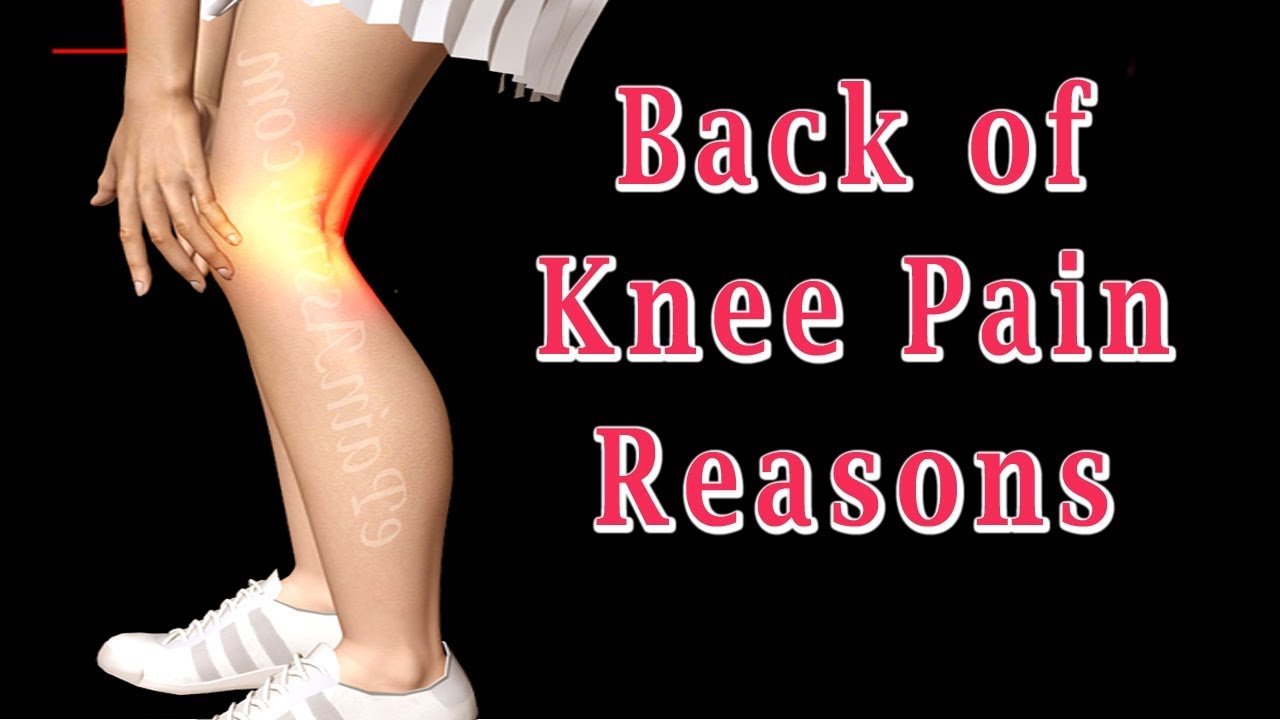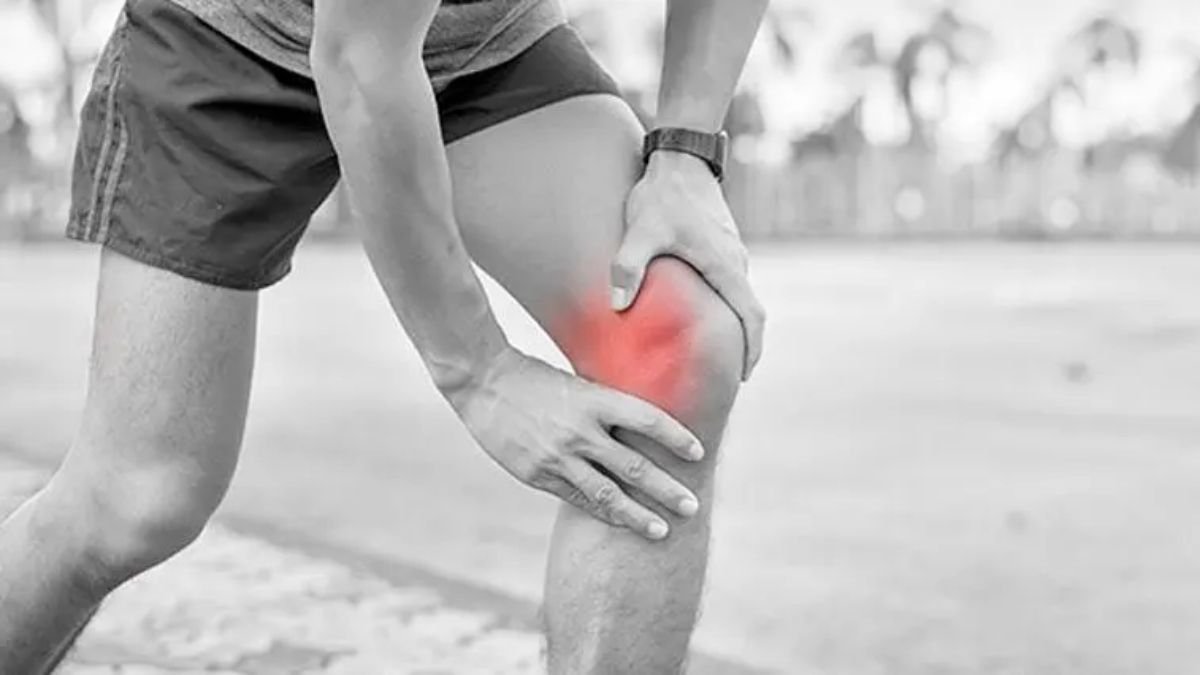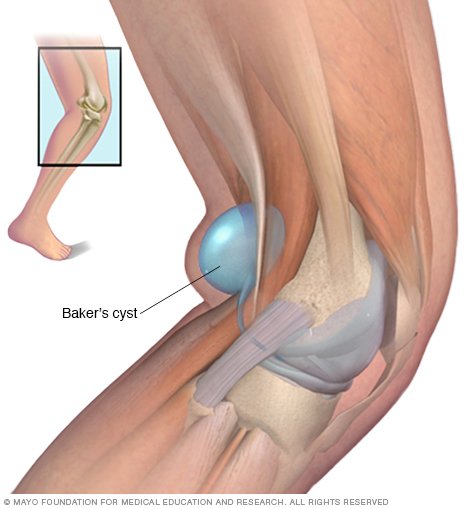Conditions Due To Cartilage Damage
There are two triangular, or wedge shaped, pieces of cartilage in the synovial joint which are called menisci. One lies on the inside, or medial side, of the knee, and one on the outside or lateral side. They act as shock absorbers between the femur and tibia, the end surfaces of which also have a cartilage covering called articular cartilage. At the front of the synovial joint is the patella which is an oval bone protecting the front of the joint and lined internally with cartilage.
What Causes Pain Behind The Knee When Bending
The most common cause of pain behind the knee when bending is a Bakers Cyst. This is when there is inflammation of the semimembranosus bursa, a small sac filled with fluid that sits at the back of the knee.
If the bursa gets inflamed, then any time you bend your knee, the bursa gets squashed, causing posterior knee pain.
Whats A Typical Treatment Plan
Treatment depends on the severity of your injury.
Conservative measures to reduce pain, rest your leg, and stretch and strengthen your leg muscles are generally the first line of treatment. Your doctor will usually advise a period of controlled rest, where you avoid activity that puts force on the knee.
Read Also: What To Do For Sore Knees From Running
The Knee Is A Complicated Joint
It’s important to remember that the knee is effectively a hinge between the hip and the ankle. It’s very rare that the problem is actually with the knee itself.
Monger-Godfrey explains: “There are so many structures involved that mean the pain is localised to the knee but you need to look at the ankle, hip and lower back. Because its so complicated, its great to treat because you often get a really good response rate.”
Why do you feel pain when cycling?;
How The Spine Causes Knee Pain

The nerve roots that transmit the sensation of pain to the legs and feet are located in the lower back. Occasionally with age or injury, the discs between the vertebrae can degenerate or bulge out and press on these nerves.
When this occurs, the nerve becomes irritated and sends out pain signals. The location of the pain depends on which disc is protruding.
The severity of the pain depends on how much of the disc is pressing on the nerve. The nerves that send fibers to the knee are located at the second, third, and fourth lumbar vertebral levels in the lower back area.
If a bulging disc, bone spur, or arthritic joint in the second, third, or fourth lumbar vertebra compresses a nerve, the referred pain will often be felt in the knee.
Referred pain;is;pain;perceived at a location other than where the cause is situated. It is the result of pain signals being sent along the network of interconnecting sensory nerves.
This condition can be diagnosed by your physician with a thorough history and physical exam. If the nerve that travels to your thigh and knee is irritated or pinched, you may feel a host of symptoms, including:
- Pain in the front of your thigh
- Knee pain
- Numbness or tingling in your thigh
- Weakness in your hip or quadriceps muscles
If you have any of these symptoms, see a doctor. In some cases, the hip may be the culprit, so a careful examination is necessary to find the true cause of your knee pain.
Recommended Reading: Why Does My Knee Stiffen Up After Sitting
Knee Pain May Be A Symptom Of Sciatica
Common knee symptoms that you may experience when you have sciatica include:
- A warm sensation, sharp pain, or dull ache in the front, side, and/or back of the knee
- Inability to bear weight on the knee
- Buckling/giving out of the knee
- Weakness while extending the knee
When knee pain is a part of your sciatica symptoms, you may also experience pain in your buttock, thigh, calf, and/or foot. The pain will almost always affect one leg at a time, so knee pain in sciatica typically does not affect both knees together.
Read more about Sciatica Symptoms
Sciatica is commonly caused by a medical condition that affects your lower back. These underlying conditions may affect your spinal discs, nerve roots, joints, or soft tissues, such as muscles.
Signs It Is Time To Have Your Knee Examined
For many with knee pain, it can be difficult to determine;what are symptoms of soreness or overexertion and those symptoms that may indicate something more serious. ;Below is a helpful guide to determine when it may be time to have your knee examined by one of the;orthopedicspecialist;at Total Orthopedics and Sports Medicine;at one of our 5 locations throughout Long Island, Brooklyn and the Bronx.
Recommended Reading: How Is Knee Surgery Performed
Conditions Associated With Pain Behind The Knee
Two common conditions that cause pain behind the knee are:
- a popliteal cyst, also called Bakers cyst
- posterior cruciate ligament injury
A cyst is a collection of fluid inside a thin layer. A popliteal cyst is a cyst in the shallow depression at the back of the knee. Its often linked to other conditions affecting the knee, including osteoarthritis, rheumatoid arthritis, cartilage injuries and inflammation of the knee joint. Many types of injury can cause a collection of fluid. Often it will be a heavy blow to the front of the knee, from falling forwards or playing a contact sport. The natural mechanism of the knee pushes this excess fluid backwards and it collects in the depression at the back of the knee, over time, causing a cyst to form.
A posterior cruciate ligament injury is caused by overstretching or tearing of this ligament, which runs across the knee from the thigh to the shin bone. It often results from a heavy blow to the front of a bent knee, sometimes from falling forwards or during a contact sport, such as rugby. Other typical injuries can occur when the knee hits the dashboard during a car accident or when the leg is over-straightened and the knee is bent backwards. Doctors call this hyperextension.
You can access a range of treatments on a pay as you go basis, including physiotherapy. Find out more about physiotherapy >
I Have A Pain Behind My Knee But I Also Feel Unstable On My Feet As If My Knee Is Looser What Should I Do Right Away
An unstable knee results from a problem with the tissues that keep the knee stable. This could be a ligament injury, a meniscal tear, a patella injury or an injury to the knee capsule itself, or to the muscles which provide secondary stability. You should consult your doctor to get a proper diagnosis as soon as possible. If the problem does not clear up I would be happy to see you and assess things further.
Recommended Reading: Why Do My Knees Feel Stiff And Hurt
If You Have Leg Pain In The Back Of Your Knee Or Calf:
This is most likely a symptom of gastrocnemius tendonitis . The gastrocnemius muscle, which is the muscle that makes up your calf, controls the bending of your knees and the pointing of your toes. A sport that requires you to accelerate quickly can strain or tear the calf muscle. Other symptoms include swelling and bruising of the calf or trouble standing tiptoe.
When To See A Doctor
If you are experiencing chronic pain or pain more associated with serious injury, see your doctor promptly. Not addressing your pain properly can lead to increased pain, joint damage, and disability. Depending on the cause of your knee pain, your doctor may suggest the following treatments:
- Medications: Your doctor may prescribe medications to help relieve pain in the back of the knee and swelling and treat underlying conditions like arthritis.
- Physical therapy: Your doctor may prescribe stretching exercises or a physical therapy/rehabilitation program to help you restore range of motion, strength and stability to your knee.
- Injections: In some situations, your doctor may suggest injecting medications and other substances directly into the knee joint in order to reduce inflammation, lubricate the knee and promote healing.
- Surgery: If conservative measures do not provide relief, your doctor may recommend surgical options.
Recommended Reading: When To Go To Er For Knee Pain
I Am Training For A Marathon And Have Started To Get A Pain Behind My Knee Every Time I Run Do I Need To Rest It Or Do I Need Treatment
The nagging pain or tenderness at the back of your knee which is causing you some discomfort could be hamstring tendonitis or an injury to the popliteus muscle. Both of these conditions are caused by overuse and repetitive actions. You should take a rest from training for a while and use the RICE treatment. If the problem does not clear up I would be happy to see you and assess things further.
Medial And Lateral Knee Pain

Lateral knee pain refers to pain on the outside of the knee, whilst medial knee pain is felt on the inside. Again, a tight IT band and quads can be to blame but more often than not, Monger-Godfrey says pain here is simply referral from the causes mentioned above.
Cleat positioning is an exception to this rule, and is a common cause of medial and lateral knee pain. Unless you’re correcting a specific issue, your cleats should be set up straight. If theyre tilted inwards, your knee will be forced to follow the ankle and track inwards and vice versa.
There are many intricate alterations a professional bike fitter can make to find the optimum cleat position. But for a basic, neutral position, George says: people try to do all sorts of clever things but really they should be under the ball of the foot imagine standing on tip toes they should be right there, that places the cleat directly below the ball of the foot so you shouldnt have problems.
Don’t Miss: How Long Does It Take To Recover From Knee Replacement
A Sudden Severe Pain Or Popping Sound Accompanied By Swelling And A Feeling Of Looseness Of The Joint And Instability
This may be due to damage to one of the knee ligaments, and is commonly seen as a result of sports injuries concerned with a sudden impact, twisting ;or over stretching. If the ligament is torn or twisted it is a sprain . If you suspect a damaged ligament you should comply with the RICE procedure, but not immobilise the joint as there is a risk of stiffness and possible muscle atrophy. The injury should be clinically assessed, and may need surgery.
When Should I See A Doctor
The majority of knee injuries, especially minor ones, can be treated at home. However, if you have any of the following symptoms you should seek medical assistance.
- Severe pain in or around the knee, especially during walking.
- Severe swelling in the knee.
- An audible pop or crack in the knee joint that is painful.
- A giving way feeling in the knee during walking or going up/downstairs.
- A feeling when the knee locks whilst bending or straightening it.
- Altered sensation in the foot such as a feeling of pins and needles or a loss of feeling in the lower leg.
- Inability to complete your normal daily activities after the initial 72 hours.
- More on when to see a doctor
Recommended Reading: How Do I Get Rid Of Dark Elbows And Knees
Biceps Femoris Tendon Avulsion
An avulsion strain occurs when a tendon tears pulling a small piece of bone with it. Like a Biceps femoris tendon strain, this occurs through sprinting or kicking activities. If you suspect you have an avulsion injury, seek professional advice. An X-ray is needed to confirm the diagnosis. Symptoms of an avulsion strain:
- A sudden severe pain at the back of your knee .
- Sudden swelling and tenderness at a point on the back of your knee.
- More on biceps femoris tendon avulsion
What Are Some Common Knee Problems
Many knee problems are a result of the aging process and continual wear and stress on the knee joint . Other knee problems are a result of an injury or a sudden movement that strains the knee. Common knee problems include the following:
ACL Tears in Female Athletes: Q&A with a Sports Medicine Expert
Sports injury prevention isn’t a one-stop shop, especially for injuries like ACL tears, which are four to eight times more common among women than men. Discover ways for women to help prevent this common injury.
You May Like: What Can You Take For Knee Joint Pain
Calf Or Hamstring Strain Or Cramp
Sudden activity and overuse are two leading causes of pain behind the knee due to a calf or hamstring strain or cramp, according to Dr. Tanaka. Movements that require pushing off or severe knee bending cause this calf and hamstring pain, respectively. Both can be managed with ice, rest, gentle stretching, and anti-inflammatories; however, one should seek care if there is swelling or persistent pain associated with this to rule out blood clots, Dr. Tanaka says. Dr. Lyons adds that although an orthopedist could treat this, if you cant bear weight on the knee or are at risk of falling, then its time to go to the emergency room. Heres what else could be causing pain in your calf.
Overload And Spring Knee
Finally there are cases where a cyclist suffers from knee pain simply because theyve done too much, too soon. Commonly called spring knee its frequently a result of a sudden increase in mileage in an attempt at last minute fitness gains.
George says: You can get tendinitis in there often riders have a break over winter then they go out and carry on riding like they were theyll get tendinitis because the muscle just isnt ready. From that point of view, they need load strength work in the hamstring if theyre getting a dull aching pain. Its important to stretch the hamstring then too.
He adds: From a coaching perspective only ever add 10% of duration if someone suddenly goes from nothing to 4 hours, theyre going to get pain. Same for intensity if you increase intensity you need to back down on volume and ensure youre getting rest.
Spring knee is also sometimes associated with over-gearing, so it’s often a good idea to use smaller gears and higher cadence until the problem subsides.
Read Also: Can Cortisone Shots Help Knee Pain
What Causes Sharp Pain Behind The Knee
If you are a runner, then sharp back of knee pain often indicates a problem with the hamstring tendons, such as tendonitis. If you do a lot of cycling, then a sharp pain behind your knee is usually caused by a problem in one of the calf muscles, gastrocnemius.
If you have recently twisted your knee or had a fall, then a meniscus tear is probably causing the sharp pain.
What Does It Mean When The Back Of Your Leg Hurts Behind The Knee

Pain at the back of your knee when bending depends on several factors. These include how the pain started, your age, medical history, and so on.
If you are an athlete and/or play contact sports often, you could have:
- A hamstring or gastrocnemius tendinitis
- Pes anserine bursitis
If youre over 60 years old, you could have:
- A leg cramp
- Bakers cyst
- Knee arthritis
- DVT.
If youre not sure or if youve had pain for more than 6 weeks, go to the doctor to find out whats going on.
Also Check: How To Put On Above Knee Prosthesis
What Is A Bakers Cyst
A Bakers cyst, also known as a popliteal cyst or synovial cyst, is a soft, fluid-filled lump that forms on the back of your knee. Like many diseases and disorders, this cyst is named after the doctor who first described it. In the mid-1800s, Dr. William Morrant Baker concluded that these popliteal cysts resulted from fluid flowing out from a damaged knee joint. When structures in or around the joint are damaged, your knee produces extra fluid that can only flow one way so it forms a cyst on the back of your knee.
How Is A Bakers Cyst Diagnosed
You need a professional medical exam to diagnose a Bakers cyst. During your appointment, your healthcare provider may do several tests to both confirm the Bakers cyst and figure out what might be causing it, including:
- Taking a medical history: Your healthcare provider will ask you about any previous injuries you may have had to your knee and go over your entire medical history.
- X-ray: This test wont necessarily show the Bakers cyst itself, but it can be used to see if you have arthritis in your knee. Arthritis is one of the possible causes of a Bakers cyst.
- Magnetic resonance imaging scans: An MRI uses magnetic waves instead of X-rays to show detailed images inside the body. This test can give your provider even more information about what might be causing the Bakers cyst.
- Ultrasound: A simple and painless test, an ultrasound uses sound waves to determine if the lump is solid or fluid.
Read Also: How To Use Ginger For Knee Pain
Why Does My Knee Hurt When I Straighten It
Your knee is made up of bones, cartilage, muscles and tendons. When you extend your knee, your quadriceps muscles tighten, and your hamstrings relax. Pain on knee straightening is usually indicative of damage or overuse of the quadriceps muscles, leading to tiny tears in its tendon. Pain may also occur due to any damage to the joint itself. You may get pain specifically in the back of the knee due to cyst formation following injury of the joint.